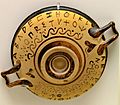Rho facts for kids
 |
|||
Quick facts for kids Greek alphabet |
|||
|---|---|---|---|
| Αα | Alpha | Νν | Nu |
| Ββ | Beta | Ξξ | Xi |
| Γγ | Gamma | Οο | Omicron |
| Δδ | Delta | Ππ | Pi |
| Εε | Epsilon | Ρρ | Rho |
| Ζζ | Zeta | Σσ | Sigma |
| Ηη | Eta | Ττ | Tau |
| Θθ | Theta | Υυ | Upsilon |
| Ιι | Iota | Φφ | Phi |
| Κκ | Kappa | Χχ | Chi |
| Λλ | Lambda | Ψψ | Psi |
| Μμ | Mu | Ωω | Omega |
| Other letters | |||
| Ϝϝ | Digamma | Ϟϟ | Koppa |
| Ϛϛ | Stigma | Ϡϡ | Sampi |
| Ͱͱ | Heta | Ϸϸ | Sho |
| Ϻϻ | San | ||
Rho (looks like Ρ for big letters and ρ for small letters) is the 17th letter in the Greek alphabet. It helps make the "r" sound in both old Greek and modern Greek.
What is Rho?
In the Greek number system, Rho has a value of 100. Some letters in other alphabets came from Rho. For example, the letter R in our alphabet (the Roman alphabet) came from Rho. Also, the Cyrillic letter Р (used in languages like Russian) came from Rho.
Where is Rho Used?
You might see the small letter Rho (ρ) in science.
- In statistics, ρ can show how two things relate in a group. This is called "population correlation."
- In physics, ρ is used to talk about density. Density tells us how much "stuff" is packed into a certain space.
Images for kids
See also
 In Spanish: Ρ para niños
In Spanish: Ρ para niños

All content from Kiddle encyclopedia articles (including the article images and facts) can be freely used under Attribution-ShareAlike license, unless stated otherwise. Cite this article:
Rho Facts for Kids. Kiddle Encyclopedia.

